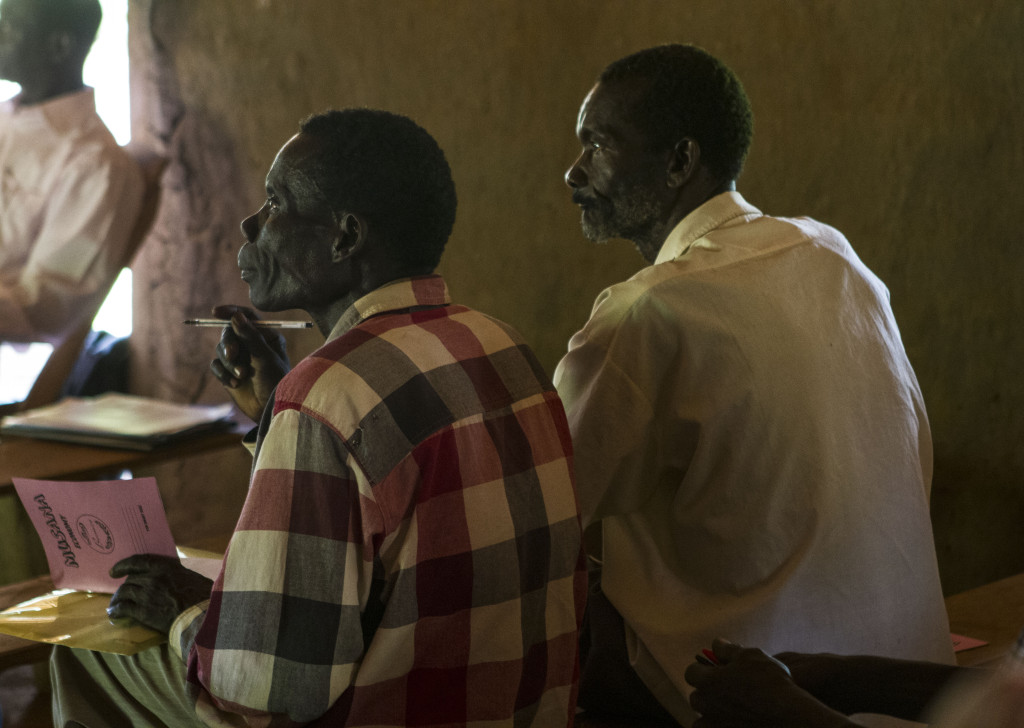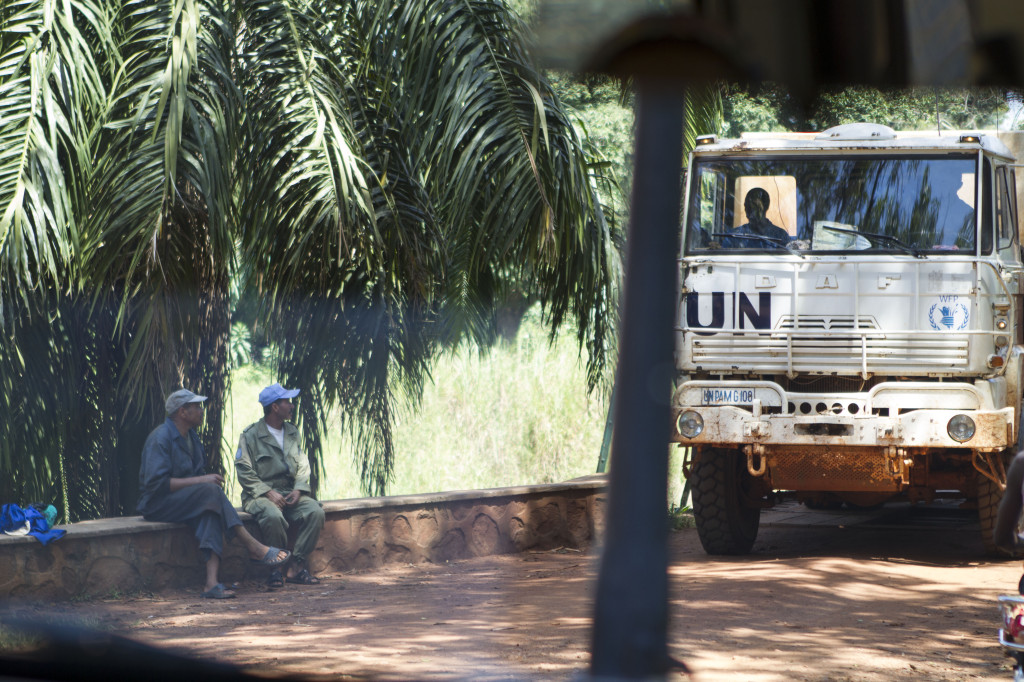Last fall we shared a bit about a workshop that was taking place at Invisible Children’s regional office in Kampala, Uganda planning the development of Community Defection Committees throughout the LRA-affected regions in central Africa. Well, since then big things have happened…
We’re excited to announce that this most recent Invisible Children program is now successfully up and running and expanding into new communities across the region.
Under the umbrella of our Defection Programming, Invisible Children has recently launched its latest project, Community Defection Committees or ‘CDC’s’. This project was designed in partnership with the organization Discover the Journey (DTJ) and local NGOs across DRC, CAR, and South Sudan. These committees are being established in communities that are amongst those most affected by LRA violence and will provide an avenue for international, regional, and local actors to collaborate on efforts to mitigate the LRA conflict.
This project just kicked off late 2013, and will continue to expand throughout 2014. We’re real excited. And we have a feeling after reading this, you will be too.
What is a Community Defection Committee (CDC)?
A CDC is a committee comprised of 8-12 people in villages that are in areas of frequent LRA activity. The members of the CDC are nominated and elected by their communities, who in turn appoint a CDC president. Committees include both men and women, and will often include prominent leaders in the community.
The specific responsibilities of CDCs will vary depending on their respective country, region, and village, but the ultimate function for all CDCs is to organize, implement, and encourage community led defection efforts. They will serve their communities as the primary source of information on LRA activity and facilitate community sensitization methods in partnership with local NGOs.
Back up… sensiti-what? And what are ‘community led defection efforts’?
Community led defection efforts will also vary depending on the community and their resources, but the general idea is that these communities, are empowered to take the lead in creating their own ‘Come Home’ messaging for the LRA. Examples include, locally produced defection fliers, ‘offerings of peace’ (such as small amounts of food or soap) to leave at locations where LRA have previously tried to surrender, handwritten notes to leave along roads, or even their own radio ‘come home’ messages.
Community sensitization means sensitizing, or preparing, individuals and the community to the idea of accepting LRA defectors into their village. Particularly in isolated regions where information about the LRA is limited, populations in central Africa may not know that the LRA is largely comprised of fighters who were abducted as children and are looking for opportunities to escape and return to their homes. Also, because all the communities have experience some level of LRA violence, sensitization helps bridge the gap between fear and forgiveness (but we’ll get into this a bit more below—see Mobile Cinema below).
Ok, so what was the idea behind creating CDCs? I mean, why now?
Great question—and to answer in the in the words of our Counter-LRA Programs Manager, Sean Poole: “We can drop a million fliers, but if there’s no one on the ground to receive LRA when they try to defect, we’re missing opportunities”.
While defection materials have been effective at convincing LRA combatants to surrender, the mechanisms in place to accept LRA who want to leave have been missing. Invisible Children recognizes these gaps, and is now working so that those civilians who are closest to this conflict are included in the development of defection tactics and community rehabilitation.
The communities most affected by LRA violence are incidentally the front-lines of the LRA defection process. Countless civilians from communities across DRC, CAR and South Sudan have reported being just outside their village, often farming or collecting water, when LRA escapees will approach them, asking to surrender. However, because there has been little effort to involve communities in the LRA defection process, many of these encounters unfortunately become missed opportunities to remove these combatants from the battlefield. There is no protocol on what these civilians should do if they have contact with LRA, and in turn they often flee the scene in fear of being attacked. The LRA escapees are then left to return to the bush.
Additionally, local leaders in DRC, CAR, and South Sudan who have been working on— and living in—the LRA conflict since it moved into central Africa in 2008 have valuable and unique knowledge of how the LRA affects their particular communities. The CDC project provides a space for Invisible Children to team up with these local leaders and organizations so that we can work collaboratively towards peace in their regions.

Where are CDCs?
The first CDC was established in Djabir, DRC (as shown in the short video above), followed by one in Kpaika, DRC and then Mboki, CAR. There are several more between DRC, CAR, and South Sudan that are in the planning stage, and we hope to continue working with communities to establish many more by the end of the year.
All of these villages have already volunteered to be Safe Reporting Sites (SRS)— identified locations at which LRA combatants can safely surrender their weapons and begin the long process of reintegration. By establishing CDCs at these SRSs, these communities will be prepared if and when LRA defectors find their way into their village.
Wait, ‘SRS’ sounds familiar… Refresh my memory.
Safe Reporting Sites (SRS) are communities across DRC, CAR, or South Sudan that have been identified as strategic locations for LRA defection by local, regional and international actors. They are identified on maps on the back of Invisible Children’s defection fliers so that when LRA get a hold of one of the fliers, they can find their way to one of these communities. These particular communities are strategic either because of their geographical location, UN presence, or because of specific LRA activity.
Currently there are eight Invisible Children established SRSs across DRC, CAR, and South Sudan. Some of the CDCs will be implemented SRSs currently identified on IC’s defection materials, while several CDCs will be organized in communities that want to become SRSs.
What does CDC training look like?
These community elected CDC members participate in an intensive several day workshop led by Invisible Children’s local partners during which they are be trained on how to safely encourage and accept LRA defectors who might approach anyone in their community. These committee members are walked through protocol detailing how to handle defectors beginning from first encounter all the way to handing the defector over the appropriate authorities. Also as a part of CDC training, communities are encouraged to create their own defection materials so rather than LRA only seeing fliers that have international branding on them, potential defectors can be assured that communities are extending their own invitations to surrender.
The final, but critical part of establishing SRSs and CDCs, is using Mobile Cinema to sensitize the entire population of participating villages to the concept of accepting LRA defectors.

What is Mobile Cinema and how does it help with community sensitization?
Invisible Children partnered with the media-based organization, Discover the Journey, who has used Mobile Cinema for trauma therapy and sensitization in LRA affected communities in the past. Using a projector and a large inflatable screen, the CDC and Invisible Children’s local partners who are trained in trauma therapy, show a fiction film in their communities that tells the story of a child who is abducted into the LRA, and the difficult process he must go through to defect. By using the power of story, mobile cinema is an effective way to convey to communities that defection and reintegration is the most promising way to peacefully end the war.
This all sound great, but IS it safe?
Another great question. Before we begin planning SRS/CDC/Mobile Cinema we consult with these strategically located communities and explained the idea behind them—including the possible risk it may pose to CDC members and their communities. We certainly would not, and could not, move forward without the absolute consent and invitation from both communities and Invisible Children’s local partner organizations. Each village has been willing to take on any additional risks the project may pose, many suggesting their insecurity is already so severe they’d welcome any opportunity to work towards peace in the region.
Additionally, all communities have either local or national security presence in and around their communities that are aware of the CDCs, the additional risk it poses, and therefore will be on alert for any increased LRA activity in response to defection programming.

Wow. How is this incredible project possible?
YOU. The Community Defection Committees and Mobile Cinema project are groundbreaking developments not just for Invisible Children programming, but for the LRA conflict—and none of this would be possible without your support. CDCs help bring Invisible Children’s defection programming full circle: we drop the fliers, LRA escape, CDCs help facilitate their defection, and the rehabilitation and reintegration process begins. Thank you for supporting Invisible Children’s defection efforts as we all work together towards peace in central Africa. We’ll continue to keep you posted as the rest of the CDCs are established across DRC, CAR and South Sudan.
Think people should hear about this?